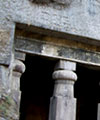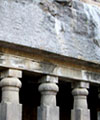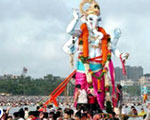| Encyclopedia of Tours and Travel to Maharashtra, featuring information on Fairs & Festivals, Wildlife, Excursion, Adventure and Weather of Maharashtra. |
 |
 |
 |
 |
 |
 |
 |
||
|
Mumbai
Pilgrimages Malabar Hill The Banganga Tank, attached to the temple, is the oldest standing structure in Mumbai. Hindu mythology has it that Lord Rama, on his way to Sri Lanka to rescue his kidnapped wife, Sita, felt thirsty and stopped at the location of the Banganga Tank and shot an arrow into the ground. A water fountain erupted and Rama quenched his thirst. It is believed that the very same hole in the ground still fills the Banganga tank till today. A Jain temple dedicated to Adinath, the first Jain Tirthankara, and the ParsiTower of Silence is two other religious structures in this district. Malabar Hill has three of the best parks in Bombay namely Hanging Gardens, Kamala Nehru Park, and Priyadarshini Park. Some of the poshest people come to walk in these parks in the evening especially in Priyadarshini Park, which is adjacent to the Arabian Sea. The Malabar Hill district is a upmarket area of downtown Mumbai, and is home to several business tycoons, corporate high rollers and film personalities. The official residence of the Chief Minister of Maharashtra (Varsha) is located here. The Hanging Gardens of Mumbai and Kamala Nehru Park are located in this area. A unhindered view of Back Bay, with the Girgaum Chowpatti beach in the foreground, and the Nariman Point skyline in the background are one of the reasons for the sky-rocketing real-estate prices in this district (Rs. 20000+, or US$ 444+ per square foot). Cave Temples in and around Bombay The Kanheri caves in the Borivili National Park are the remains of old Buddhist cave temples. Karla Caves containing Chaityas from the second century BC, are about 114 kms from Bombay. There are two other complexes of caves close by.
Elephanta Caves It is visited by hundreds of domestic and foreign tourists. In recent years complaints have been made that visitors mistreat this important cultural and historic site. The caves are thought to date back to the Silhara kings of the 9th through 13th centuries (810-1260). Some of the sculptures of this site are also attributed to the imperial Rashtrakutas of Manyakheta (in present day Karnataka), the Trimurti of Elephanta showing faces of Brahma, Vishnu, and Maheswar embodied as one being one among them. This was also the royal insignia of the Rashtrakutas. Other Rashtrakuta sclptures here are the reliefs of Nataraja and Sadashiva and the splendid sculptures of Ardhanarishvara. About the Trimurti, historian Grousset points out, "The three countenances of the One Being are here harmonized without a trace of effort. There are few material representations of the divine principle at once as powerful and as well balanced as this in the art of the whole world". The site of these magnificent caves contained beautiful reliefs, sculptures, and a temple to the Hindu god Siva. The caves are hewn from solid rock. Entrance to the dargah History As many as 40,000 pilgrims visit the shrine on Thursdays and Fridays. Non-Muslims are also permitted to walk on the causeway and into the mosque compound. The only area out of bounds for non-Muslims is the sanctum sanctorum of the mosque itself. The structure The dargah Most of the structure is corroded due to saline winds blowing from the surrounding sea. It was last repaired in the 1960s, but civil engineers say the structure is beyond further repair. The Dargah Trust is awaiting permission to raze the structure and rebuild it with Makrana marble, the same marble used to build the Taj Mahal. Permission must be obtained from the Central Government as the shrine lies within the Coastal Regulation Zone. |
|||||||||
|
|||||||||
|
|||||||||
|---|---|---|---|---|---|---|---|---|---|